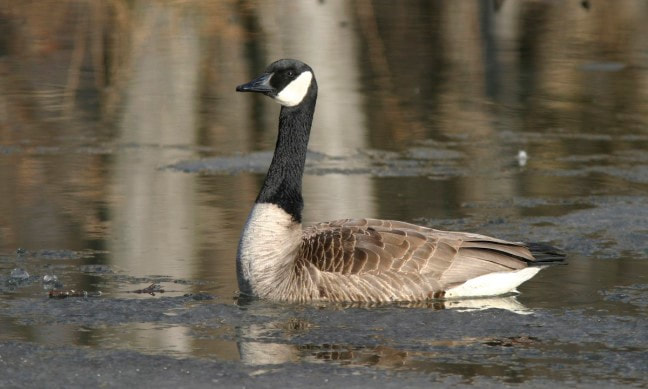|
Canadian Geese have been on my mind a lot lately. This past winter I have missed the skeins of geese that fly back and forth up and down the river appearing every single morning like clockwork. In Abiquiu when winter turned to spring I noted that the geese were behaving in much the same way the Sandhill cranes did before they migrated, splitting into pairs or groups of three and flying erratically. I was puzzled. I didn’t recall witnessing such behavior before this year. I wondered about migration patterns. Were the geese shifting their flight patterns too? Or perhaps the small groups I saw were staying year round? Some days it almost seemed as if these water birds were confused by something.* I saw three Canadian geese on the last predawn walk I took to the river/Bosque, just an hour or two before leaving for Maine. I knew that a perilous journey was ahead because we were driving. The C/virus was a frightening threat though I brought all food, and would camp/use woods as bathroom. The first morning after my arrival in Maine I saw and heard three geese honking over my head. I was struck by the odd synchronicity – (three geese at the beginning and ending of the journey). I remembered the mother goose tales of my childhood also recalling their mythology. Mother Goose is a benign and loving image of the ancient mother goddess that is present throughout world mythologies. Goddess spirituality understands nature to be the body of the goddess and affirms that the earth is our home. This world is understood to be an interconnected web of life shared by humans and non humans alike. (International scholar/writer Carol Christ)
This earth based way of being in the world allows us to be present for human and nonhuman species in a compassionate way – a way that is not based on ‘power over’ and privilege but on respect and equality. The Indigenous Way. I like to think that the presence of geese at both ends of a challenging cross country trip were acknowledging the completion of a safe passage. The Canadian Goose is native to North America and it breeds in Canada and the northern United States in a wide range of habitats. By the early 20th century over hunting and loss of habitat decimated populations almost to the point of extinction, but with the help of preservation programs most populations have recovered. In some areas these birds are regarded as pests. Many are routinely shot. I find this behavior sad and ironic because the root of this problem belongs to humans who have killed off the birds natural predators, as well as the fact that people have created an abundance of man made bodies of water near food sources like those found on golf courses, manicured green lawns, public parks, lakefront cottages, and beaches in planned communities. Geese love succulent grasses, sedges, aquatic vegetation, cultivated grains, seeds and berries. They also eat insects and some crustaceans. Geese mate for life; life-long pair bonds are formed during the second year. Offspring remain with their parents for about twelve months traveling together in large flocks of family groups. The female chooses the nest site, which can be found in unlikely spots like cliff ledges as well as on elevated hummocks near water. Geese need good visibility to protect their eggs and young goslings. The male defends their territory with elaborate displays well worth watching! Some geese don’t migrate at all and live year-round in the southern part of their breeding range, which includes both coasts and parts of northern Mexico. When the geese fly over in their characteristic “V” shaped patterns I am compelled to stop to watch this astonishing sight. If they do migrate, geese tend to breed in northern areas in the US and Canada. Sometimes geese fly to Alaska or the sub – arctic to raise their families. When migrating, if one Canadian goose falls injured, immediately two companions accompany the goose to the ground and do not leave until the bird either recovers or dies. I have observed evidence of this kind of animal compassion throughout nature in every species I have ever studied. The geese that migrate return to the exact nesting and overwintering locations every year. In fact, migrating geese use various stop-off resting points when they travel, and these remain largely the same, too. When geese fly south to overwinter, they usually settle somewhere in the middle or southern continental US. The geese that you see every spring or fall are probably the same geese that were around your home the year before. Since that first morning I have seen a few more geese – not the V shaped skeins but small groups that are flying or swimming in nearby ponds. During the late spring I look forward to seeing the parents with their fluffy waddling toddlers feeding at the water’s edge. I am perpetually amazed at how fast the youngsters grow. Geese have beautiful feathers and every summer I collect a few. This year when I find my first flight feather I will be thanking Old Mother Goose for her help. * This narrative was published in a journal just this past week and a number of folks responded to my observations about the geese. These people came from Texas, the Hudson Valley in NY, California, Illinois and all noted the same strange goose behavior I have witnessed in Abiquiu and Maine.
0 Comments
Your comment will be posted after it is approved.
Leave a Reply. |
Submit your ideas for local feature articles
Profiles Gardening Recipes Observations Birding Essays Hiking AuthorsYou! Archives
September 2025
Categories
All
|

 RSS Feed
RSS Feed